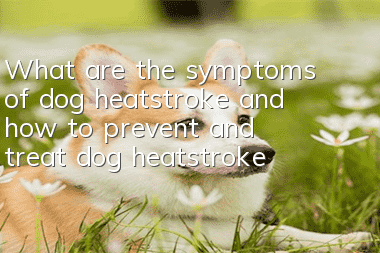What are the symptoms of dog heatstroke and how to prevent and treat dog heatstroke?

Dogs are different from humans in that their skin does not have sweat glands. They can only rely on rapid breathing to discharge most of the heat through the mouth, and a small amount of heat through the foot pads.
Therefore, under the influence of high temperature, high humidity, confined space and strong sunlight, dogs produce more heat, dissipate less heat, and store too much heat in the body, which will cause meningeal congestion and central nervous system dysfunction. This is heatstroke in dogs.
Symptoms:
Initial stage:
Extreme thirst, shortness of breath, and elevated body temperature;
Salivation, vomiting, bright red tongue and pale gums, thick saliva, rapid heart rate;
diarrhea.
Later period:
Difficulty breathing and abdominal breathing;
Visible mucosal cyanosis, bloody diarrhea or vomiting;
convulsions, shock, and even death.
Treatment:
1. Immediately move the sick dog from a high temperature or sun-exposed environment, and take the dog to an air-conditioned room or a ventilated and cool room.
2. Use cold water to bathe, cover the body with a wet towel, and put an ice pack on the head to cool down. Be careful not to let the water temperature be too low, because too low a water temperature will cause the surrounding blood vessels to contract violently, which will not achieve the cooling effect. You can also use Wipe the body surface with alcohol to promote heat dissipation.
3. Heat stroke is prone to laryngeal edema. You should pay attention to the breathing situation and straighten the dog’s neck at any time to make it breathe smoothly.
4. During the emergency treatment, pay attention to the body temperature of the dog at all times. When the body temperature drops to 38 degrees, all heat dissipation actions should be stopped to avoid excessive heat dissipation and hypothermia.
5. If vomiting occurs, the vomit should be carefully removed from the mouth and the head should be turned downward to prevent the dog from inhaling the vomit into the trachea, causing aspiration pneumonia.
6. Give your dog some water containing electrolytes.
7. Once you find that your dog has symptoms of heat stroke, you need to seek medical attention immediately.
Prevention:
Pay attention to the physical condition of the dog. Short-nosed dogs have difficulty breathing. Older, obese, and dogs with a history of heart disease or epilepsy are more likely to suffer from heatstroke.
Always keep your dog with plenty of drinking water.
Make sure the dog’s environment is cool and ventilated, and prevent the dog from being alone.
Avoid walking your dog during the hottest hours of the day. Wait until the air has cooled before going out. Walking your dog in the early morning and evening is best..
- How to raise a dog to be particularly loyal? Dog training tips!
- How to solve the problem of dogs causing destruction at home? The method is very important!
- Common Dog Diseases and Prevention
- How often should dogs be dewormed?
- How to tell if a dog is blind
- Why does a dog urinate blood? Poop shovelers should pay attention...
- What is the best medicine for Shiba Inu Kennel Cough?
- What can’t Bedlington Terriers eat?
- What is the most effective way for dogs to eat to gain weight?
- The dog's food-protecting behavior has a lot to do with its owner. How can it be improved?



